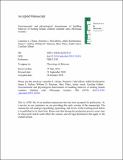Files in this item
Environmental and physiological determinants of huddling behavior of molting female southern elephant seals (Mirounga leonina)
Item metadata
| dc.contributor.author | Chaise, Laureline L. | |
| dc.contributor.author | McCafferty, Dominic J. | |
| dc.contributor.author | Krellenstein, Adélie | |
| dc.contributor.author | Gallon, Susan L. | |
| dc.contributor.author | Paterson, William D. | |
| dc.contributor.author | Théry, Marc | |
| dc.contributor.author | Ancel, André | |
| dc.contributor.author | Gilbert, Caroline | |
| dc.date.accessioned | 2019-10-30T00:36:55Z | |
| dc.date.available | 2019-10-30T00:36:55Z | |
| dc.date.issued | 2018-10-30 | |
| dc.identifier | 256401064 | |
| dc.identifier | 8697bd02-da79-4f4e-afe3-00c9ee959277 | |
| dc.identifier | 85056996494 | |
| dc.identifier | 000456753900023 | |
| dc.identifier.citation | Chaise , L L , McCafferty , D J , Krellenstein , A , Gallon , S L , Paterson , W D , Théry , M , Ancel , A & Gilbert , C 2018 , ' Environmental and physiological determinants of huddling behavior of molting female southern elephant seals ( Mirounga leonina ) ' , Physiology & Behavior , vol. In press . https://doi.org/10.1016/j.physbeh.2018.10.016 | en |
| dc.identifier.issn | 0031-9384 | |
| dc.identifier.other | RIS: urn:278352FB8B9B39E7915676D165562CEF | |
| dc.identifier.uri | https://hdl.handle.net/10023/18799 | |
| dc.description | The overall study was funded by the IPEV (Program 1037 HEnergES), doctoral fellowships of French Ministry of Higher Education and Research, the University of St Andrews, the Marine Alliance for Science and Technology for Scotland (MASTS) and the Carnegie Trust for the Universities of Scotland. | en |
| dc.description.abstract | While endotherms can rely on their insulation to reduce heat loss to adapt to cold environments, renewing of fur during molt impairs insulation while they have to perfuse the periphery to support epidermal tissues. The southern elephant seal Mirounga leonina undertakes an annual catastrophic molt while fasting on land in a wet, windy and cold environment. However, southern elephant seals show characteristic aggregation patterns that are predicted to reduce high metabolic costs during the molt. Between 2012 and 2016, 59 female elephant seals were tracked on land during their molt to study their aggregation behavior in relation to molt stage, habitat type and local weather conditions. Infrared thermography and stomach temperature loggers were used to observe variation in body surface and internal temperature in relation to molt stage and aggregation behavior. We found that thermal constraints varied during the molt, with a peak in surface temperature during the mid-stage of the molt. Wallows (mud pools) appear as favorable habitat to aggregate while molting. Indeed, wallows offered a warmer microclimate with greater ground temperature and lower wind speed. Moreover, there was a greater proportion of aggregated seals and larger group size in wallows. These aggregation patterns in wallows were influenced by local weather such that a greater proportion of seals were located in the center of the aggregation, and larger group size occurred during days of unfavorable meteorological conditions. We also observed a higher proportion of seals at mid-stage of molt amongst aggregated seals compared to isolated individuals. This aggregation behavior may reduce the cost of thermogenesis as surface body temperature and stomach temperature were cooler by 1.0 °C and 1.5 °C, respectively, in aggregated compared to isolated seals. As a consequence, huddling behavior may be thermally advantageous for female southern elephant seals during the molt. | |
| dc.format.extent | 3378796 | |
| dc.language.iso | eng | |
| dc.relation.ispartof | Physiology & Behavior | en |
| dc.subject | Phocids | en |
| dc.subject | Aggregation behavior | en |
| dc.subject | Heat loss | en |
| dc.subject | Habitat type | en |
| dc.subject | Meteorological variations | en |
| dc.subject | Stomach temperature | en |
| dc.subject | QH301 Biology | en |
| dc.subject | NDAS | en |
| dc.subject.lcc | QH301 | en |
| dc.title | Environmental and physiological determinants of huddling behavior of molting female southern elephant seals (Mirounga leonina) | en |
| dc.type | Journal article | en |
| dc.contributor.institution | University of St Andrews. Sea Mammal Research Unit | en |
| dc.contributor.institution | University of St Andrews. School of Biology | en |
| dc.identifier.doi | https://doi.org/10.1016/j.physbeh.2018.10.016 | |
| dc.description.status | Peer reviewed | en |
| dc.date.embargoedUntil | 2019-10-30 | |
| dc.identifier.url | https://www.sciencedirect.com/science/article/pii/S0031938418302786#s0110 | en |
This item appears in the following Collection(s)
Items in the St Andrews Research Repository are protected by copyright, with all rights reserved, unless otherwise indicated.

